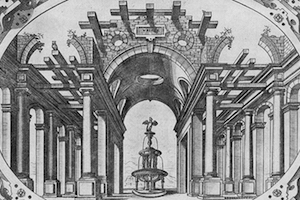Originally developed in the ecological circles of the 1970s that pursued critical alternatives to the modernist worldview, the concept of ‘resilience’ has pervaded 21st-century thought, from psychology to political theory, and from planning to architecture. In most of its current guises, it has been used in positivist and future-oriented frames of thinking that limit it to an aspired benchmark for managing crises and withstanding catastrophic events. This Special Collection attempts to recuperate the overlooked potential of ‘resilience’ by asking whether its introduction in architectural history can transform current disciplinary practices. In their articles, the contributing authors revisit buildings that have been reused and transformed to withstand change over the centuries. Adopting the long-term perspective of ‘resilience’, they examine these physical objects as carriers of multiple layers of interventions, re-evaluate their architects’ and users’ intentions and reconsider their place in architectural history. In many cases, ‘resilience’ offers a novel historiographical perspective that unveils long-standing conceptual schemata which still condition the historians’ interpretation of the past. In the final instance, ‘resilience’ illuminates the deep-seated modernist dichotomy between ‘innovation’ and ‘tradition’ in architectural history. It offers a significant alternative to 21st-century architectural historians’ established views on modernity that are still embedded in their thought and practice.
Editorial
From the Pantheon to the Anthropocene: Introducing Resilience in Architectural History
Elizabeth Mays Merrill and Stylianos Giamarelos
2019-06-13 Volume 7 • Issue 1 • 2019 • Volume 7 • 7
Also a part of:
Position Paper
Building with Time, History, and Resilience at Yale
Marvin Trachtenberg
2019-06-13 Volume 7 • Issue 1 • 2019 • Volume 7 • 10
Also a part of:
Research Article
Buildings for Bodies of Work: The Artist Museum After the Death and Return of the Author
Maarten Liefooghe
2019-06-13 Volume 7 • Issue 1 • 2019 • Volume 7 • 12
Also a part of:
Housing Paul and Paula: Building Repair and Urban Renewal in the German Democratic Republic
Andreas W. Putz
2019-06-13 Volume 7 • Issue 1 • 2019 • Volume 7 • 11
Also a part of:
Through History and Technique: Pier Luigi Nervi on Architectural Resilience
Micaela Antonucci and Sofia Nannini
2019-06-13 Volume 7 • Issue 1 • 2019 • Volume 7 • 9
Also a part of:
Thermal Sustainability: Renovation of Imperial Thermae in Late Antiquity
Allyson McDavid
2019-06-13 Volume 7 • Issue 1 • 2019 • Volume 7 • 8
Also a part of:
Three Lessons from Japan on Architectural Resilience
Ariel Genadt
2019-07-22 Volume 7 • Issue 1 • 2019 • Volume 7 • 16
Also a part of:
Resilient Matters: The Cathedral of Syracuse as an Architectural Palimpsest
Jo'anne Van Ooijen
2019-12-18 Volume 7 • Issue 1 • 2019 • Volume 7 • 26
Also a part of:
Collections
-
The Two Mediterraneans that Live Apart, Together: Making Architectures and Writing Histories
Women’s display. Women’s exhibitions and exhibition design in the 20th century
Building Civic Identities. Communal Palaces in Italian Urban History (14th-17th Centuries)
Intersecting Practices: Architecture and the Visual Arts in Early Modern Europe - Italy and the Netherlands
The Geopolitical Aesthetic of Postmodernism
Architects as Global Entrepreneurs (1850-2000)
From Ration Cards to Refugee Camps: Architecture, Bureaucracy, and the Global State of Emergency during World War One
Comprador Networks and Comparative Modernities
Architectural Historiography and Fourth Wave Feminism
Marxism and Architectural Theory across the East-West Divide
Resilience in Architectural History
On Style
On the meaning of 'Europe' for Architectural History
Travel
Building Word Image: Printing Architecture 1800-1950
Objects of Belief: Proportional Systems in the History of Architecture
Culture of Crisis
